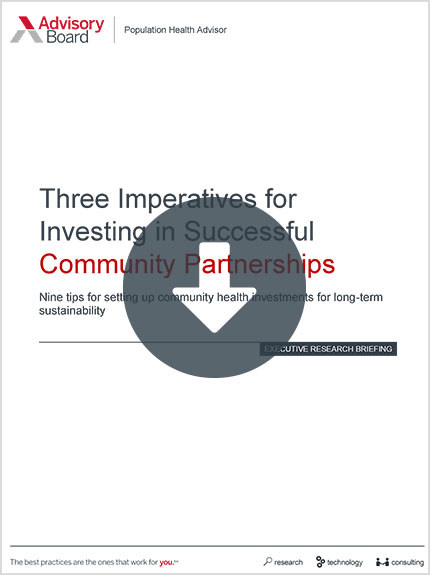Auto logout in seconds.
Continue LogoutRead Advisory Board's take: Why population health efforts must come from within an organization
Kaiser Permanente last week announced it will launch Thrive Local, a social health network aimed at connecting health and social services providers to better coordinate and improve patient care.
Details on Thrive Local
The partnership is part of Kaiser's mission to treat "total health" by accounting for patients' social and community needs.
Kaiser is developing Thrive Local in partnership with Unite Us, a New York-based company that creates software to connect health care and social services providers to better coordinate and improve patient care. The software also tracks outcomes and helps community care partners collaborate with providers on care.
The program will be incorporated with Kaiser's EHR systems and will allow health providers to connect patients to a variety of community resources for social needs, such as food insecurity or housing instability.
Kaiser will roll out Thrive Local this summer, and within three years Kaiser plans to roll out the program to all of its 12.3 million members.
Discussion
Kaiser Chair and CEO Bernard Tyson in a statement said that Kaiser "has long understood that total health can only be achieved through a combination of physical, mental, and social care. In order to thrive, people need access to the things that are vital to health such as secure housing and nutritious food."
Webconference series: Population Health 101
Bechara Choucair, chief community health officer at Kaiser, said Thrive Local will build upon the work Kaiser has already done addressing patients' social determinants of health, and that Kaiser will partner with a variety of community organizations that will be included within the new social care network.
"We really have to understand the supply and demand when it comes to social health," Choucair said. "And we know that this is going to be a long process and we need to do it carefully and thoughtfully community by community."
Imelda Dacones, president and CEO of Kaiser's Northwest Permanente, said, "To address total health, we, as physicians, need systems and networks that address our patients' social needs. Health care in this country must continue to evolve from acute episodic care to an integrated coordinated system focused on prevention and coordinated care management" (Truong, MedCity News, 5/6; Ross Johnson, Modern Healthcare, 5/6; Gooch, Becker's Hospital Review, 5/6; Kaiser Permanente press release, 5/6).
Advisory Board's take

Tomi Ogundimu, Practice Manager, Population Health Advisor and Darby Sullivan, Senior Analyst, Population Health Advisor
Kaiser has joined a growing number of providers investing in technology platforms to help scale partnerships with community organizations and increase patient access to social resources. Although traditional ad-hoc referral methods (e.g., referencing a community resource "bible" or relying on anecdotal reviews of organizations) have sufficed for fledgling programs, those approaches are almost impossible to scale as investments increase and programs mature.
“Providers must be as selective about their partners as they are with traditional clinical partnerships”
When providers like Kaiser chose to funnel significant capital into addressing the social determinants of health, they must be as selective about their partners as they are with traditional clinical partnerships (like preferred post-acute provider networks). The Thrive Local network is unique in its promise to track quality outcomes of community partners, facilitating a more strategic approach to referrals and community investment. Usually, after referring patients to the top-performing organizations in their communities, frontline staff may come up against a black box of information. Instead, Thrive Local intends to enable EHR-based, cross-industry communication so the care team can remain in the loop on patient care.
Importantly, Kaiser's investment in the Unite US platform stands as only one component of their extensive, multi-year approach to addressing each community's entrenched social determinants of health. Through their stated commitments to extensive investments in housing, food insecurity, and even gun violence and climate change, Kaiser is signaling that provider organizations cannot expect to achieve real change or a high social and capital ROI in the short term. Community transformation requires at least a 10-year strategy in order to truly affect structural issues (e.g., racism, physical environment, poor infrastructure) which are rooted in long-held barriers.
As we've learned from anchor institutions—safety-net hospitals with deeply held missions of community health improvement—it's not enough to talk about stated community goals and just be involved in external initiatives. At anchor institutions, transformation starts within the organization across four key areas:
- Leadership: Accelerate diversity and inclusion in leadership to reflect demographic parity of the population served;
- Workforce: Increase efforts to hire locally with a strategy that ensures manager comfort and removes workplace barriers to entry. Review hourly wages of support staff and create career paths for to support those interested (e.g., getting from MA to RN);
- Data analysis: Modify how and what type of data is tracked. Incorporate human-centered measures to internal dashboards based on what matters to patients and the community;
- Supply chain: Move investments beyond charity care by purchasing locally when possible—in order to not only improve the organization's brand, but also help infuse capital to drive community-wide economic strength.
To learn how your organization can build effective community partnerships, download out report on 3 Imperatives for Investing in Successful Community Partnerships. Then, to get the tools you need to choose the best community interventions for your market, download our 10 Tools for Prioritizing Community Health Interventions.
Don't miss out on the latest Advisory Board insights
Create your free account to access 1 resource, including the latest research and webinars.
Want access without creating an account?
You have 1 free members-only resource remaining this month.
1 free members-only resources remaining
1 free members-only resources remaining
You've reached your limit of free insights
Become a member to access all of Advisory Board's resources, events, and experts
Never miss out on the latest innovative health care content tailored to you.
Benefits include:
You've reached your limit of free insights
Become a member to access all of Advisory Board's resources, events, and experts
Never miss out on the latest innovative health care content tailored to you.
Benefits include:
This content is available through your Curated Research partnership with Advisory Board. Click on ‘view this resource’ to read the full piece
Email ask@advisory.com to learn more
Click on ‘Become a Member’ to learn about the benefits of a Full-Access partnership with Advisory Board
Never miss out on the latest innovative health care content tailored to you.
Benefits Include:
This is for members only. Learn more.
Click on ‘Become a Member’ to learn about the benefits of a Full-Access partnership with Advisory Board
Never miss out on the latest innovative health care content tailored to you.

